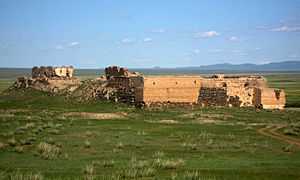Choghtu Khong Tayiji

Tsoghtu Khong Tayiji, born Tümengken (Classical Mongolian: Tümengken čoγtu qong tayiǰi; modern Mongolian: Цогт хунтайж, Tsogt Khun Taij; 1581–1637), was a noble in Northern Khalkha. He expanded into Amdo (present-day Qinghai) to help the Karma Kagyu sect of Tibetan Buddhism but was overthrown by Güshi Khan, who supported the rival Geluk sect.
He established a base on the Tuul river. Known as an intellectual he embraced the Karma sect and built monasteries and castles.
He submitted himself to Ligdan Khan, last grand khan of the Mongols. He took part in Ligdan's campaign to Tibet to help the Karma sect although Ligdan Khan died in 1634 before they joined together. But he pursued the campaign. In the same year he conquered the Tümed around Kokonor (Qinghai Lake) and moved his base there. By request from Shamar Rabjampa he sent an army under his son Arslan to central Tibet in 1635. However, Arslan attacked his ally Tsang army. He met the fifth Dalai Lama and paid homage to Gelukpa monasteries instead of destroying them. Arslan was eventually assassinated by Tsoghtu's order.
The Geluk sect asked for help Törü Bayikhu (Güshi Khan), the leader of the Khoshuud tribe of the Oirat confederation. In 1636 Törö Bayikhu led the Khoshuud and the Dzungars to Tibet. In the next year a decisive war between Tsoghtu Khong Tayiji and Törü Bayikhu ended in the latter's victory and Tsoght was killed.
Descendants of Sutai Yeldeng, Tsoghtu's grandson, succeeded the jasagh of a banner in Sain Noyon Khan Aimag.
He has traditionally been portrayed as evil by the Geluk sect. On the other hand, the Mongolian movie "Tsogt taij" (1945) treated him as a national hero. It reflected the communist regime's attitude toward Tibetan Buddhism.